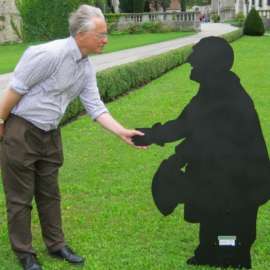This was a programme that presented what are probably each of its composers' most popular works, played by one of London’s very best orchestras, under the direction of one of Europe’s most venerable and respected conductors. Add to that the winning presence of a young and vibrant soloist, and it is not surprising that the concert was well attended. And on the whole the concert delivered what it promised. Kurt Masur appears now, at 85, more frail than hitherto, and his entrance, assisted solicitously by soloist Arabella Steinbacher, made one concerned as to whether he would still be up to the challenge. In the event, we need not have worried. He stood throughout, not a conductor’s chair in sight, and conducted both works from memory.
Steinbacher’s performance showed admirable restraint. Hers is a virtuosity unencumbered by ostentatious display or overt emotionalism. It was playing of immense beauty, light agility and secure intonation, that never thrust itself forward outside the arena of a communal music-making. The balance between her and the orchestra, appropriate for a concerto in which the soloist at times takes on the role of accompanist, was such that the solo violin was always part of the overall picture. She gave us many sublime moments – the close of the first theme exposition as she handed over to the woodwind for the second theme was particularly rapt, as was a deftly handled cadenza, and in the slow movement she withdrew into passages of heartfelt inwardness. In the finale, Allegro molto vivace, she was light, bright, and rather quiet. The contribution of the orchestra was never quite so alert as that of their soloist, and they really sounded rather weary in this last movement, but the performance overall left the touching impression of a restrained and rather melancholy perfection – a view of Mendelssohn’s concerto as unusual as it was affecting.
When Elgar heard Bruckner’s Seventh Symphony, on its first performance in the UK in 1887, he noted in his programme: ‘Nice intro’. The ‘intro’ is indeed very nice, a rising E major arpeggio on cellos supported by first horn which reappears on full brass at the end of the whole work – so it’s always good if the conductor is able to finish the symphony at the same speed at which he started. It’s marked ‘Allegro moderato’, but few conductors can resist a slower tempo for this ravishing theme and this creates a problem for its return at the very end. Masur’s solution in this performance was an enormous sudden slowing-down in the last movement coda, so that the horns, trumpets and Wagner tubas could deliver the theme with a stately nobility comparable to that with which it first entered. He also tied the two moments together in orchestration by suppressing the cellos altogether at the opening, so what we had was a beautiful solo horn, played by the orchestra’s new principal horn, Kate Woolley, and not a cello theme at all.
Throughout the first movement Masur had adopted an almost unchanging tempo; even in the climactic moment in the development where the opening arpeggio theme is inverted, where most conductors feel the need to speed up, he kept it steady, so there was no need for an ungainly rit for the recapitulation. The orchestral playing was far more committed than it had seemed in the Mendelssohn: the Philharmonia strings were warm and purposeful, with the double-basses encouraged to supply a firm rhythmic base, and the violins giving expressive accounts of the lyrical second subject and rising to the challenge of the glorious Adagio. The Wagner tubas weren’t quite as trenchant with their opening statement as they became later on. Masur’s tempo was never sluggish, he avoided any superficial dramatic gestures, and there was no cymbal clash and triangle at the movement’s climax. In the closing pages of the Adagio, after a wonderfully played dirge for Wagner tubas, violins are in quiet dialogue with solo flute and clarinet – this was playing of great intensity, the hall deathly quiet.
The Scherzo was perhaps the least attractively played – rather slow and stolid. Bruckner’s marking is ‘Sehr schnell’ – very fast – which this wasn’t, but it nevertheless took its place as consistent with Masur’s general approach. The Finale was very impressive. As a shorter and lighter movement, it needs careful handling for it to be appropriate to the weight of what has gone before. Here the strength of Masur’s lifetime knowledge of the work came through, and the careful handling of tempi and detailed observation of dynamics brought the movement to life: it sailed along merrily until that immense slowing down in the coda, the Philharmonia brass distinguishing themselves mightily in the stirring summation that closes the work. There was a moment’s stunned silence. Then came the storming applause.


